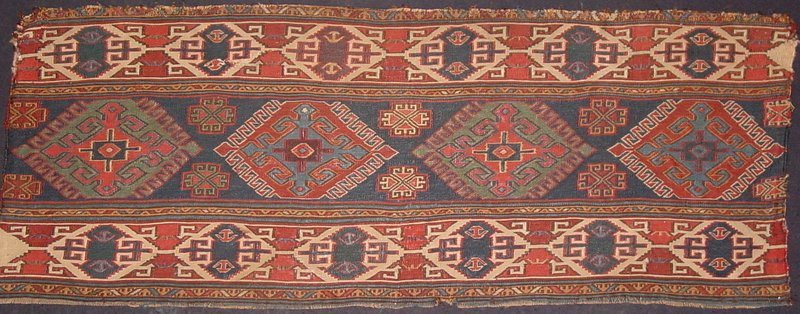|
|
#1 |
|
Members
Join Date: Sep 2008
Location: Rochester, NY
Posts: 11
|
I have noticed on a few Shahsavan sumacs that it appears that purple may be obtained by overdying red with indigo. So, as is common with some greens, the indigo rubs off leaving the red (or in the case of green, yellow) behind.
Here is an example  Has anyone else encountered this? Is this a common practice? Is it limited to a particular group of dyers? I have most often seen it on mafrash panels with this drawing.  Thanks Jim Last edited by Jim Miller; February 11th, 2021 at 08:49 PM. |
|
|
|
|
#2 |
|
Administrator
Join Date: May 2008
Posts: 163
|
Hi Jim,
I'm not certain that I am focusing on the same feature as that which you are describing. But what the heck, here's a couple images. These are from a Bijar kilim (full piece at bottom) that we have; is this the particular color phenomenon you are referring to ?:    Regards Chuck |
|
|
|
|
#3 |
|
Members
Join Date: Sep 2008
Location: Rochester, NY
Posts: 11
|
Chuck,
First off, fantastic Bijar! You example is actually better than mine. You can see that the wefts that are closer to the surface are redder than those that are buried, that are deeper purple. It looks like the blue indigo has worn off the surface revealing the underlying red. I am curious how common this approach was to create purple and whether it can be used to define a certain weaving group. Cheers Jim |
|
|
|
|
#4 |
|
Members
Join Date: Jun 2012
Posts: 16
|
Hi Jim
I have owned quite a few Shahsavan pieces with various purples but I have never seen this colour before. No doubt your mafrash is Shahsavan, but I cannot say what that tells us. Regards Richard Tomlinson |
|
|
|
|
#5 |
|
Members
Join Date: Sep 2008
Location: Rochester, NY
Posts: 11
|
Here are 3 more examples of Shahsavan mafrash panels combining blue over red to generate purple. Two are sumac and the middle one is flat weave
     
|
|
|
|
|
#6 |
|
Members
Join Date: Oct 2009
Posts: 153
|
Hi Jim,
I can't contribute any information about the frequency of (or any tribal preference for-) successive dyeing operations with indigo and natural red to obtain this kind of strong and a bit dullish purple-violet shades, but the concept must have been pretty obvious to Persian and Turkik dyers, since a yellow on indigo was by far their most frequent choice for obtaining saturated green shades and very strong bluish-black surmey shades were often obtained by correcting the strong reddish navy of conc. indigo, through a second dyeing with a yellow or a beige natural dye. There aren't really good alternatives to successive dyeing with indigo and a red.(1) For technical reasons, (the limited resistance of natural red- and yellow dyes to successive reduction and oxidation) I would rather start with the indigo vat dyeing, then, after a good rinsing, proceed with the mordant dyeing with red or yellow. Imho, this would lead to a much more predictable and reproducible shade. Besides it would also make more sense for nomad dyers, who may tend to trust the indigo dyeing to city workshops and do only the easier mordant dyeing with a red. (Keeping a stable indigo vat bath in nomadic day-life is surely no piece of cake). These successive dyeing operations, with indigo and a red or a yellow, have inherently a high risk of abrash (both micro- and macro-abrash), the former one being due to the fact that it is indeed difficult to obtain a perfectly uniform penetration and distribution of the indigo molecule into the fiber under the conditions encountered by pre-industrial dyers: Under pre-industrial dyeing conditions, indigo vat dyeing easily will lead to some premature formation of the blue pigment ( insoluble form of the dye) on the fiber surface, by oxidation. Where this does happen, tiny parts of the fiber surface will be 'reserved' ( dyer's jargon for saying that these little parts of the fibre are not anymore accessible by the soluble form of indigo dye and thus are less penetrated than other places, or not penetrated at all). Depending on the intensity of the rinsing which follows this indigo vat dyeing process, these tiny 'scales' of 'surface pigment' are more or less completely eliminated. Thus, during the subsequent process, the red or yellow dye will now be able to access most un-dyed places too. Thus the micro-abrash.(2) However, were the rinsing insufficient, some 'surface pigment' may still stick to the fibre during the following fibre-mordanting, and perhaps even during the final dyeing process. This would reduce partially, or block altogether, the access of the red or yellow dye and lead to red or yellow spots of various saturations or even to fully white ones. Whenever the 'scales 'of surface pigment manage to subsist through all these processes, they still may be eliminated later, by abrasion ,during rug weaving, or later still, during the career of the rug, leading to even more micro-abrash. As you well know, our eyes are much more sensitive to yellow-blue abrash than to a red-blue one. Please also bear in mind that the angles with which light hits the fibre can create a kind of pseudo-metamery ( small variations of the shade and brightness) and such differences in light incidence do naturally exist at the bottom of the knot. Kind regards Pierre Note: (1) A less popular alternative to successive indigo & red dyeing for obtaining purple-violet shades was a mordant dyeing with roots of a variety of Alkanna tinctoria. Dyeing must be performed in booze though, ca. 50 % strength. There is no particular risk of micro-abrash in this process, but definitely a risk for the dyer, mainly of meeting pink elephants or ,worse still, an angry imam and of losing his horse driver license. Another rather acrobatic option would be using a red Rubbia dye on wool mordanted with traces of copper. These recipes are poorly reproducible and will yield, at best, very dull purple-violets or, more likely than not, brown shades and deep frustration. Ooh, and I forgot another option, which may have been used relatively often, seems quite contra-intuitive, but works reasonably well, despite a certain lack of shade reproducibility. One makes first a brown with a Rubbia, on wool mordanted with Alum and carefully dosed iron salt, (or mordanted with iron salt alone very carefully dosed too!). I suspect that one needs more experience and much more luck that what I have usually, to obtain a reproducible brown at this stage. Then, a second treatment of this brown wool in an alkaline bath turns it dull purple. Interestingly this shade change is stable, which probably indicates that the alizarin-iron metal complex has been modified. Turkmen would probably use ashes of the desert plant which is their main fire wood. Dullish purple shades can also be obtained by mordant-dyeing with 'lac' dye, but they would show little blue content, unless a bit of pale indigo or Saxon blue dyeing would have been performed. (The latter being a lousy but very old semi-synthetical dye). (2) The root cause for macro-abrash in pre-industrial times was different: It was mainly the rather small dyeing vessels and therefore the small batches of dyed wool, combined with the near-impossibility for pre-industrial dyers to reproduce, batch after batch, exactly the same shade, due to the variability of key parameters like bath temperature, bath pH, water composition (hardness, traces of Fe..), concentration and composition of natural dyes, concentration and purity of natural alum, dyeing time, wool quality (natural shade, brightness, scouring quality,-, denier,..) etc... 
Last edited by Pierre Galafassi; March 7th, 2021 at 07:32 AM. |
|
|
|
|
#7 |
|
Administrator
Join Date: May 2008
Location: Massachusetts
Posts: 159
|
Pierre, once again:
      Joel |
|
|
|
|
#8 |
|
Members
Join Date: Sep 2008
Location: Rochester, NY
Posts: 11
|
Pierre,
Thanks very much your reply. I had always thought of the indigo dying being second, since it was on the surface. It is interesting to learn that the chemistry favors indigo dying first. I guess it would still leave indigo on the surface and would allow the red or yellow dyes to penetrate deeper into the wool fibers. I also appreciate you clear explanation of micro-abrash. That can certainly account for some of the heterogeneity in the examples I have found. Tho, particularly in the example that Chuck shared, the preponderance of the red showing through appears to be on strands that are closer to the surface of the finished weaving, suggesting that they resulted from abrasion of the surface Indigo. Finally, you mentioned that nomadic groups are likely to use city dyers for indigo. I have read that nomadic groups often used established dye shops to obtain their dyed wool samples, but had not really considered that they might combined by city dyed wool with home dyed wool. Do you have a sense on how common this was? Thanks again for your thoughtful and scholarly (as always) reply. Cheers Jim |
|
|
|
|
#9 |
|
Members
Join Date: Oct 2009
Posts: 153
|
Hi Jim,
I have no first hand information  about the proportion of Turkmen weavers which would prefer buying the indigo-dyed wool rather than dyeing it themselves. about the proportion of Turkmen weavers which would prefer buying the indigo-dyed wool rather than dyeing it themselves.That some did, is mentioned by visitors and written in various rug books. I suppose that the option makes good sense. The weaver's decision probably depends on a number of factors, economical ones, proximity of a market city, state of the relations with this city, whether the family is moving frequently or stays for a while in a yaoul, for example. (1) A wealthy Turkmen selling or bartering, on the Khiva or Bokhara market, a couple of sheep and the Persian lad captured during his last alaman, would be quite likely to add to his own shopping list, next to tea (the main luxury and a necessity as well), some gun powder, perhaps a cast-iron pot or some silver bling for his wife and enough indigo-dyed wool for a khali and a couple of bags. A 'tschomri', temporarily settled in a Yaoul, (often an older, influential and wealthier man) will perhaps chose the option of indigo home-dyeing, while a 'tscharwa' (usually a younger member of the family / clan), who frequently moves his yurt following the sheep, horses, camels from pasture to pasture, but not necessarily a destitute, since he may participate to alamans and have served as auxiliary in the Uzbek Khanate cavalry and may own many sheep himself, will probably rather buy indigo-dyed wool, since keeping an indigo vat is hardly compatible with a busy nomadic life. Indigo dyeing also requires much more experience than a mere mordant dyeing with Rubbia and one does not want to waste expensive, imported indigo, I suppose. (1) Any Turkmen would surely know wool qualities better than the city dyer from which he would buy the indigo-dyed wool. Rest assured that it will suit the weaver's needs. Kind regards Pierre Last edited by Pierre Galafassi; February 25th, 2021 at 08:39 AM. |
|
|
|
|